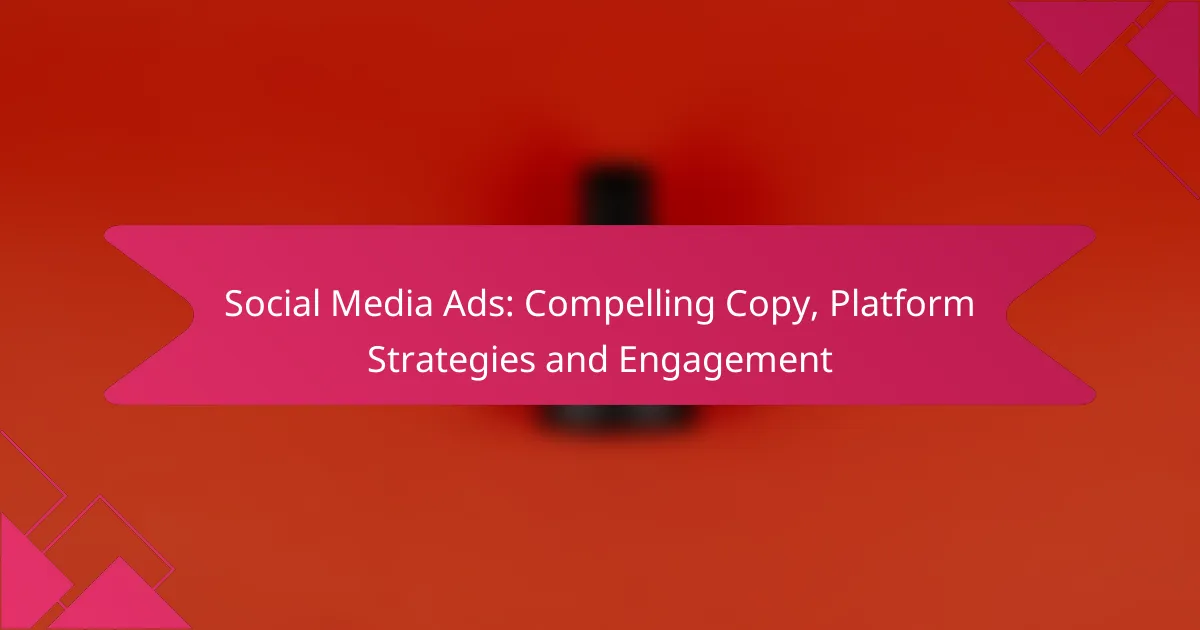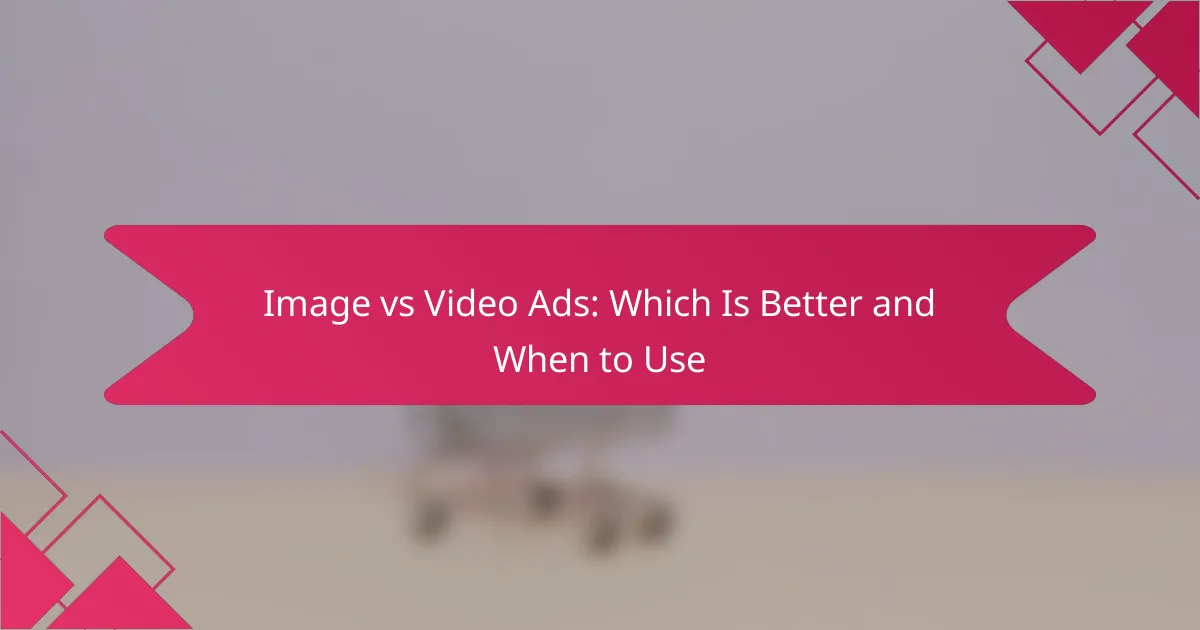Social media advertising offers a variety of ad formats, including image, video, carousel, story, and collection ads, each tailored to specific campaign goals. Whether aiming to increase brand awareness, generate leads, or drive traffic, understanding the right format and strategy is essential for effective audience engagement. Key performance metrics such as click-through rate and return on ad spend provide valuable insights for optimizing campaign effectiveness.

What are the best social media ad formats for businesses?
The best social media ad formats for businesses include image ads, video ads, carousel ads, story ads, and collection ads. Each format serves different campaign goals and can significantly impact engagement and conversion rates.
Image ads
Image ads are straightforward and visually appealing, making them ideal for brand awareness and product promotion. They typically consist of a single image along with a caption or call-to-action.
To maximize effectiveness, use high-quality images that resonate with your target audience. Keep text minimal and focus on a strong visual that communicates your message quickly.
Video ads
Video ads are dynamic and can convey a narrative, making them effective for storytelling and showcasing products in action. They can range from a few seconds to several minutes, depending on the platform and campaign goals.
Consider using engaging visuals and sound to capture attention within the first few seconds. Aim for concise messaging and a clear call-to-action to drive conversions.
Carousel ads
Carousel ads allow businesses to showcase multiple images or videos in a single ad, enabling users to swipe through them. This format is effective for displaying a range of products or features.
Each card can have its own link, making it easier to direct users to specific landing pages. Use compelling visuals and concise descriptions to encourage interaction and engagement.
Story ads
Story ads appear in a full-screen format and are designed for temporary viewing, usually lasting 24 hours. They are ideal for creating urgency and engaging users with immersive content.
Utilize vertical video or images that capture attention quickly. Incorporate interactive elements like polls or swipe-up links to enhance user engagement and drive traffic.
Collection ads
Collection ads combine images and videos to create a visually rich experience, allowing users to browse products directly within the ad. This format is particularly effective for e-commerce businesses.
When using collection ads, ensure that the featured products are relevant and visually appealing. Include a clear call-to-action to guide users toward making a purchase or exploring more options.

How do social media ad campaigns achieve specific goals?
Social media ad campaigns are designed to meet distinct objectives, such as increasing brand awareness, generating leads, driving website traffic, or boosting engagement. Each goal requires tailored strategies and ad formats to effectively reach and resonate with the target audience.
Brand awareness
Brand awareness campaigns focus on making potential customers familiar with a brand’s identity and offerings. These ads typically use visually appealing content and broad targeting to reach a wide audience.
Common formats include image ads, video ads, and carousel ads that showcase multiple products. A good practice is to use clear branding elements and engaging visuals to capture attention quickly.
Lead generation
Lead generation campaigns aim to collect contact information from potential customers, often through forms or landing pages. These ads usually offer incentives, such as free trials or downloadable resources, to encourage users to share their details.
Utilizing lead forms directly within the social media platform can streamline the process, making it easier for users to convert. It’s essential to ensure that the value proposition is clear and compelling to maximize sign-ups.
Website traffic
Website traffic campaigns are designed to drive users to a specific website or landing page. These ads typically include a strong call-to-action and link directly to relevant content, products, or services.
Using link ads or dynamic ads that showcase specific products can be effective. Monitoring click-through rates (CTR) and optimizing ad placements can help improve performance and ensure a good return on investment.
Engagement
Engagement campaigns focus on increasing interactions with content, such as likes, shares, and comments. These ads often feature compelling visuals and questions to encourage audience participation.
Utilizing formats like polls, contests, or interactive videos can enhance user engagement. It’s important to respond to comments and foster a community around the content to maintain momentum and build relationships with the audience.

What are the key performance metrics for social media ads?
Key performance metrics for social media ads include click-through rate (CTR), conversion rate, return on ad spend (ROAS), and cost per click (CPC). These metrics help advertisers evaluate the effectiveness of their campaigns and optimize their strategies for better results.
Click-through rate (CTR)
Click-through rate (CTR) measures the percentage of users who click on an ad after seeing it. A higher CTR indicates that the ad is engaging and relevant to the audience. Generally, a good CTR for social media ads ranges from 1% to 3%, but this can vary by industry.
To improve CTR, focus on creating compelling ad copy and eye-catching visuals. A/B testing different headlines and images can help identify what resonates best with your target audience.
Conversion rate
The conversion rate is the percentage of users who complete a desired action after clicking on an ad, such as making a purchase or signing up for a newsletter. A strong conversion rate typically falls between 2% and 5%, depending on the industry and campaign goals.
To enhance conversion rates, ensure that landing pages are optimized for user experience and aligned with the ad’s messaging. Clear calls to action and minimal distractions can significantly boost conversions.
Return on ad spend (ROAS)
Return on ad spend (ROAS) measures the revenue generated for every dollar spent on advertising. A ROAS of 4:1 is often considered a good benchmark, meaning that for every dollar spent, four dollars are earned in return.
To maximize ROAS, continually analyze ad performance and adjust targeting, bidding strategies, and creative elements. Monitoring trends and customer feedback can also guide effective adjustments.
Cost per click (CPC)
Cost per click (CPC) refers to the amount an advertiser pays each time a user clicks on their ad. CPC can vary widely based on competition, industry, and targeting options, with typical ranges from a few cents to several dollars.
To manage CPC effectively, set clear budget limits and utilize bidding strategies that align with your campaign goals. Regularly reviewing and optimizing ad performance can help lower CPC while maintaining effectiveness.

What factors influence social media ad performance in the US?
Social media ad performance in the US is influenced by several key factors, including target audience, ad placement, budget allocation, and ad creative quality. Understanding these elements can help advertisers optimize their campaigns for better results.
Target audience
Identifying the right target audience is crucial for effective social media advertising. Advertisers should analyze demographics, interests, and online behavior to tailor their messages. For example, targeting younger audiences may require a more dynamic and visually engaging approach.
Utilizing tools like Facebook Audience Insights or Instagram analytics can help refine audience segments. Advertisers should continually test and adjust their targeting based on performance data to ensure they reach the most relevant users.
Ad placement
Ad placement refers to where ads appear on social media platforms, which can significantly impact visibility and engagement. Options include feeds, stories, and sidebars, each with different user interactions. For instance, story ads often yield higher engagement due to their immersive format.
Advertisers should consider the context of each placement. Ads in users’ feeds may require more compelling visuals, while story ads can leverage quick, attention-grabbing content. Testing various placements can reveal which options yield the best performance for specific campaigns.
Budget allocation
Effective budget allocation is essential for maximizing ad performance. Advertisers should determine how much to spend on each platform and campaign based on their goals and expected returns. A common strategy is to allocate a larger portion of the budget to high-performing ads while experimenting with smaller amounts on new formats.
Monitoring key performance indicators (KPIs) such as cost per click (CPC) or return on ad spend (ROAS) can guide budget adjustments. It’s advisable to set aside a portion of the budget for testing new strategies or audiences to continually improve campaign effectiveness.
Ad creative quality
The quality of ad creative plays a vital role in capturing audience attention and driving engagement. High-quality visuals, clear messaging, and strong calls to action can significantly enhance ad performance. Advertisers should invest in professional design and copywriting to create compelling ads.
Regularly updating ad creative can help maintain audience interest and prevent ad fatigue. A/B testing different creatives can provide insights into what resonates best with the target audience, allowing for data-driven improvements over time.

How to choose the right social media platform for ads?
Selecting the right social media platform for ads depends on your target audience, campaign goals, and the nature of your product or service. Each platform has unique demographics and ad formats that can significantly impact your advertising success.
Understand your target audience
Identifying your target audience is crucial when choosing a social media platform. Consider factors such as age, gender, location, and interests. For instance, younger audiences may be more active on platforms like TikTok and Instagram, while older demographics might prefer Facebook or LinkedIn.
Utilize audience insights and analytics tools available on each platform to gather data about user behavior. This information can help tailor your ads to resonate with the specific groups you want to reach.
Define your campaign goals
Your campaign goals should guide your choice of platform. If your objective is brand awareness, platforms with high engagement rates like Instagram or Facebook may be ideal. For lead generation or direct sales, consider LinkedIn or Facebook, which offer robust targeting options.
Clearly outline what you want to achieve, whether it’s increasing website traffic, boosting sales, or building community engagement. This clarity will help you select the most effective platform for your needs.
Evaluate ad formats and features
Consider experimenting with multiple ad formats, such as carousel ads, stories, or video ads, to see which performs best for your audience. Each format has its strengths, so align them with your campaign objectives for optimal results.










